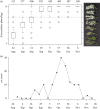Fluff-thieving birds sabotage seed dispersal
- PMID: 28280552
- PMCID: PMC5319318
- DOI: 10.1098/rsos.160538
Fluff-thieving birds sabotage seed dispersal
Abstract
Characterizing many species interactions as mutualisms can be misleading because some members of the interaction derive greater fitness benefits at the expense of other members. We provide detailed natural history data on a suspected bird-plant mutualism in South Africa where many species of birds use fluffy Eriocephalus seed material to construct their nests, potentially dispersing seeds for the plant. We focus on a common bird, Prinia maculosa, which invests heavily in gathering Eriocephalus material. Prinias spent 5 of their median 6-day nest construction period adding seed material to their nests and frequently travelled outside their territory boundary to gather Eriocephalus material. Yet, prinias gathered primarily Eriocephalus fluff and actively avoided gathering seeds. The average prinia nest contained only 6.6 seeds, but contained fluff from 579 seeds. These data suggest that prinias provide limited dispersal benefits to Eriocephalus plants. By contrast, the large amounts of Eriocephalus fluff in prinia nests, and the effort that prinias invest in gathering it, suggest that prinias benefit from constructing their nests with Eriocephalus material. We end by outlining hypotheses for possible fitness benefits that Eriocephalus material could provide prinias and other birds.
Keywords: Eriocephalus; Karoo prinia; mutualism; parasite; seed dispersal.
Figures




References
-
- Bronstein JL, Alarcón R, Geber M. 2006. The evolution of plant–insect mutualisms. New Phytol. 172, 412–428. (doi:10.1111/j.1469-8137.2006.01864.x) - DOI - PubMed
-
- Leigh GE., Jr 2010. The evolution of mutualism. J. Evol. Biol. 23, 2507–2528. (doi:10.1111/j.1420-9101.2010.02114.x) - DOI - PubMed
-
- Bronstein JL. 1994. Conditional outcomes in mutualistic interactions. Trends Ecol. Evol. 9, 214–217. (doi:10.1016/0169-5347(94)90246-1) - DOI - PubMed
-
- Yu DW. 2001. Parasites of mutualisms. Biol. J. Linn. Soc. 72, 529–546. (doi:10.1111/j.1095-8312.2001.tb01336.x) - DOI
-
- Frederickson ME. 2013. Rethinking mutualism stability: cheaters and the evolution of sanctions. Q. Rev. Biol. 88, 269–295. (doi:10.1086/673757) - DOI - PubMed
Associated data
LinkOut - more resources
Full Text Sources
Other Literature Sources
